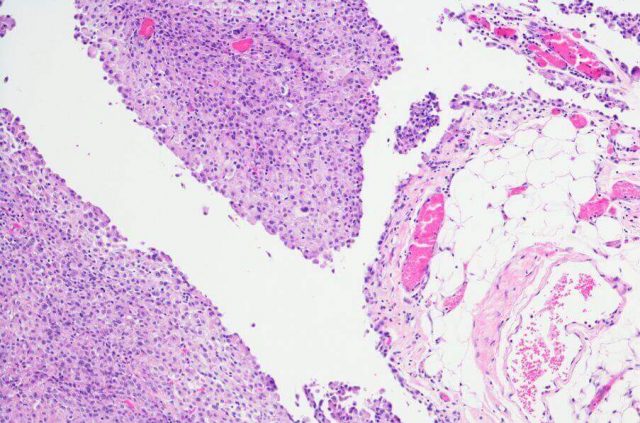Mesothelioma
Malignant mesothelioma is a rare, aggressive cancer that attacks the lining of internal organs. There is no cure for malignant mesothelioma. Asbestos exposure is the main cause of mesothelioma. The disease can take anywhere from 20 to 50 years to develop. People with mesothelioma may file lawsuits against asbestos and talcum powder manufacturers.
- Medically reviewed by Daniel A. Landau, M.D.
- Last update: October 2, 2024
Mesothelioma is cancer of the lining that protects internal organs. It most often occurs in the lining of the lungs, abdomen, heart and testicles. Mesothelioma is a rare, generally incurable cancer.
All types of mesothelioma are rare. But pleural mesothelioma is the most common type. Pleural mesothelioma occurs in the lungs.
Asbestos exposure is the most common cause of mesothelioma. People with certain genetic mutations or who had radiation treatment for cancer may also get mesothelioma.
People who worked with asbestos on the job may have developed mesothelioma. Many asbestos manufacturers filed bankruptcy and set up trusts to pay compensation.
Other people exposed to asbestos-contaminated talcum powder may also get mesothelioma. These people filed talcum powder lawsuits.
Types of Mesothelioma
There are four types of malignant mesothelioma. All types are rare. Doctors only diagnose about 3,000 new cases of mesothelioma every year. In 2018, medical providers diagnosed 2,875 cases in the U.S., and these are the most recent figures the CDC reported in March 2022.
Pleural mesothelioma
Pleural mesothelioma affects the lung cavity, or pleura. It’s the most common type of the disease. The Mesothelioma Research Foundation of America says about three-quarters of all cases are pleural. Doctors may misdiagnose it as lung cancer or viral pneumonia. Symptoms include chronic chest pain, shortness of breath, chronic coughing, weight loss and fever.
Peritoneal mesothelioma
Peritoneal mesothelioma is the second most-common type of malignant mesothelioma. It accounts for 10 to 20 percent of all cases. It attacks the peritoneum. The peritoneum is tissue that covers most of the organs in the abdominal cavity. Symptoms include weight loss, abdominal pain and swelling, bowel obstruction, blood clotting abnormalities, anemia and fever.

Pericardial mesothelioma
Pericardial mesothelioma affects the heart sac, or pericardium. It’s very rare. There are only about 150 reported cases. Doctors most often diagnose it in people 40 to 70 years old. It occurs in men more often than in women. Symptoms include chest pain, fluid buildup around the heart, abnormal or difficult breathing, chronic coughing and irregular heartbeat.
Mesothelioma of the Tunica Vaginalis Testis
The least common type of the disease is mesothelioma of the tunica vaginalis testis. It is also called paratesticular mesothelioma. This affects the lining around the testicles. Fewer than 100 cases have ever been reported. Symptoms include fluid buildup in the testes or a hernia. The main treatment is orchidectomy. Orchidectomy is removal of the affected testis.
Diagnosis and Treatment
Because mesothelioma is so rare, doctors often suspect other diseases with similar symptoms. To diagnose mesothelioma, doctors may use chest X-rays, echocardiograms, CT and PET scans and MRI.
They also take samples of tissue for a pathologist to examine. This is called a biopsy.
Curative Treatment
Doctors can treat mesothelioma, but most cases do not result in a cure. Traditional treatments include chemotherapy, radiation therapy and surgery.
Doctors will often use chemotherapy or radiotherapy to stunt the growth of a tumor before attempting surgery.
Palliative Treatment
Doctors can also provide palliative treatment for mesothelioma. Palliative treatment manages the pain and symptoms of the disease.
Two palliative procedures for pleural mesothelioma are thoracentesis and pleurodesis.
Thoracentesis is an outpatient procedure. Doctors drain the buildup of fluid in the membranes around the lungs.
Pleurodesis aims to prevent fluid buildup. Surgeons place talcum powder inside the lung cavity to create scar tissue. The scar tissue prevents fluid from building up in the space.
Asbestos and Mesothelioma
Asbestos exposure is the main cause of mesothelioma. But, not all people exposed to asbestos get mesothelioma.
Risk factors include a personal history of asbestos exposure, living with someone who worked with asbestos and a family history of mesothelioma.
The federal government began banning asbestos for various uses in 1973. Yet, manufacturers still use asbestos. Asbestos can be dangerous in any situation where fibers become airborne.
For example, people who do home renovation, shipbuilding or construction work may inhale asbestos fibers. The fibers can cause tissue scarring and genetic changes that lead to mesothelioma.
Families of people who work with asbestos can also inhale asbestos from clothing, hair or skin.
By the early 2000s, nearly a million people and families filed lawsuits against manufacturers.
Talcum Powder and Mesothelioma
Talcum powder contaminated with asbestos can also cause mesothelioma. Talcum powder exposure can be industrial or cosmetic. Asbestos-contaminated talcum powder can become airborne and enter the body.
The FDA does not allow asbestos in talcum powder. But, talcum powder manufacturers do not have to show the FDA safety studies. This means the FDA cannot guarantee that talcum powder in the U.S. does not contain asbestos.
People who work in talcum powder factories, as painters or plumbers who use talc products or any industry that uses talc may be at risk.
Consumer products such as baby powder may also expose people to contaminated talc.
Staging and Life Expectancy
Doctors rate pleural mesothelioma in four stages. They look at how far the cancer has spread to determine the stage.
Stage 1 means the cancer has not spread. Stage 4 means it has spread through the lymph nodes and other organs.
The survival rate of pleural mesothelioma varies according to the patient’s stage. Staging information is not available for other forms of mesothelioma because they are rare and not well-studied.
People who are younger and female tend to survive longer. People who are able to carry out normal tasks of daily life and have no chest pain or weight loss are also more likely to survive longer.
Calling this number connects you with a Drugwatch.com representative. We will direct you to one of our trusted legal partners for a free case review.
Drugwatch.com's trusted legal partners support the organization's mission to keep people safe from dangerous drugs and medical devices. For more information, visit our partners page.




